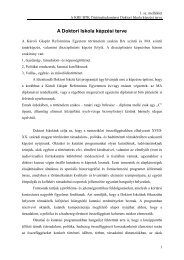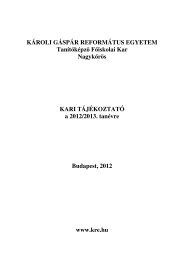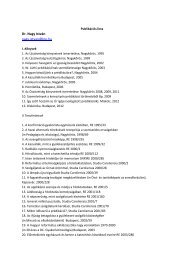collega - Károli Gáspár Református Egyetem
collega - Károli Gáspár Református Egyetem
collega - Károli Gáspár Református Egyetem
You also want an ePaper? Increase the reach of your titles
YUMPU automatically turns print PDFs into web optimized ePapers that Google loves.
order to bring the taxpayer up to the<br />
subsistence level.<br />
The proponents of flat taxation<br />
argue that it is simple and efficient,<br />
and that may be the key reason<br />
behind Eastern Europe’s dramatic<br />
growth. Others believe it is more<br />
readily explained by a low starting<br />
base and large inward investment.<br />
Flat tax has been adopted, for example,<br />
in Estonia, Lithuania, Latvia,<br />
Russia, Serbia, Ukraine, Slovakia,<br />
Georgia, Romania, and Macedonia,<br />
furthermore Greece, Croatia, and the<br />
Czech Republic are planning to<br />
introduce flat taxes.<br />
On the other hand, many people<br />
say that flat tax is not a fair tax, since<br />
flat taxes usually do not tax all<br />
income at the same rate, despite also<br />
only one single rate of tax could be<br />
involved as well on all income, but it<br />
is not common at all. For instance, in<br />
the United States usual flat tax proposals<br />
exempt certain forms of<br />
income from tax, therefore the rate of<br />
tax on those privileged forms of<br />
income is zero percent. Additionally,<br />
income derived from capital (dividends,<br />
interest, or capital gains)<br />
might be exempted from tax at the<br />
individual level. As a result, the flat<br />
tax becomes a two rate system: zero<br />
on income from capital and nominal<br />
rate on wage income.<br />
Therefore, it is said by many tax<br />
theorists that flat taxes shall not be<br />
used in advanced economies, but a<br />
progressive tax system with graduated<br />
tax shall be adopted instead on<br />
household incomes and corporate<br />
profits.<br />
A progressive tax is levied so that<br />
the tax rate increases as the amount<br />
to which the rate is applied increases.<br />
Progressive taxation can be applied<br />
to any type of tax, but it is applied<br />
mostly to income taxes, where people<br />
with a higher level of income pay a<br />
higher percentage of their income in<br />
tax than those taxpayers, who earn<br />
less income.<br />
Theorists in almost every discipline<br />
have entered the progressivity<br />
debate, proposing a variety of differdr.<br />
Ercsey Zsombor<br />
However, the measurement of<br />
subsistence level may differ according<br />
to culture, geographical and economic<br />
conditions of the country and<br />
therefore the consumer price level<br />
thereof, furthermore according to<br />
the conditions and situation of each<br />
individual (such as talents, abilities,<br />
marital status, family size, age, etc.).<br />
Also, if subsistence includes more<br />
than just material to survive with,<br />
then it is a social construct, not a fact<br />
of nature.<br />
The minimum of subsistence is<br />
also a figure that shows the minimum<br />
level of satisfying needs on the<br />
lowest level that is still acceptable for<br />
the society. It can be determined<br />
from two aspects: from the side of<br />
the particular needs, or relatively, by<br />
correlating to the average life standards<br />
of the population through consumption<br />
data. These are usually<br />
family categories, since people satisfy<br />
a great deal of their needs within<br />
their households and families. This<br />
shall be taken into account when the<br />
exemption rates are determined. 6<br />
Based on this level of subsistence,<br />
and the related tax exemption, it is<br />
common among tax theorists to<br />
divide society into two groups: relatively<br />
wealthy individuals who pay<br />
taxes, and poor individuals who are<br />
excluded from tax payment obligation.<br />
7<br />
However, in relation to tax payment<br />
obligation there is a debate<br />
regarding the fair type of tax systems.<br />
Basically two major systems<br />
may be used: flat tax (an income tax<br />
having a single rate for all taxpayers<br />
regardless of income level and type)<br />
and progressive tax (a tax that takes<br />
a larger percentage from the income<br />
of high-income people than it does<br />
from people with low-income).<br />
Flat Tax and Progressive Tax<br />
The basis of flat rate taxation, the<br />
principle that fairness requires all<br />
taxpayers to pay the same percentage<br />
of income, could be made compatible<br />
with exemptions by invoking<br />
another principle, namely that no<br />
one should be required to pay taxes<br />
until the basic subsistence needs<br />
have been met by the taxpayer and<br />
his family. Every individual shall<br />
contribute to well-being through<br />
taxes of community after meeting his<br />
own subsistence needs and that of<br />
his family. This principle implies<br />
that there is no ability to pay until<br />
subsistence needs have been met.<br />
Besides, it must be admitted additionally<br />
that demands of fairness can<br />
not be satisfied just by imposing the<br />
same rate on everyone, and this idea<br />
supports that certain exemptions<br />
must be provided. 8<br />
Therefore flat taxes, in accordance<br />
with the above principles, implemented<br />
as well as proposed, usually<br />
exempt from taxation household<br />
income below a statutorily determined<br />
level that is a function of the<br />
type and size of the household. As a<br />
result, such a flat marginal rate is<br />
consistent with a progressive average<br />
tax rate. Otherwise, all income or<br />
consumption is taxed at the same<br />
marginal rate. 9<br />
Over the past half century, the<br />
flat-rate taxation system was supported<br />
by a significant number of<br />
other political philosophers and scientists,<br />
such as Friedrich Hayek,<br />
Ludwig von Mises, Milton<br />
Friedman, John Rawls, Richard<br />
Epstein, Walter Blum, and Harry<br />
Kalven. 10<br />
The exhaustive critique of<br />
progressive taxation considered that<br />
the desirability of exemptions for<br />
low-income taxpayers does not<br />
require any justification, while Juliet<br />
Rhys-Williams developed and later<br />
Milton Friedman proposed in 1962 a<br />
negative income tax for the poor, a<br />
taxation system where income subsidies<br />
are given to persons or families<br />
who are below the poverty line. This<br />
system provides financial aid to<br />
poverty-level individuals and families:<br />
after filing a tax return showing<br />
income below subsistence level,<br />
instead of paying an income tax, the<br />
taxpayer would receive a direct subsidy,<br />
called a negative income tax, in<br />
6 ’Létminimum és társadalmi minimum’ (1991) 6 Esély. Társadalom- és szociálpolitikai folyóirat 84<br />
7 N. C. Staudt, ’The Hidden Costs of the Progressivity Debate’ (1997) 5 Vanderbilt Law Review 922<br />
8 J. F. Coverdale, ’The Flat Tax Is Not a Fair Tax’ [1996] Seton Hall Legislative Journal 285–290<br />
9 http://en.wikipedia.org/wiki/Flat_tax#_ref-0 (downloaded on 30 March, 2007)<br />
10 B. H. Fried, ’The Puzzling Case For Proportionate Taxation’ [Spring 1999] Chapman Law Review 157<br />
278 XI. évfolyam 2–3. szám

















